AMD Announces New, Higher Clocked Radeon HD 7950 with Boost
by Ryan Smith on August 14, 2012 11:00 AM ESTPerformance, Power, Temperature, & Noise
Because the 7950B is not strictly a new SKU, and because the performance of the 7950B isn’t very far ahead of the 7950, we’re going to keep our look at the 7950B’s performance relatively short. As always, if you want a complete breakdown of performance please see Bench, which has our complete results for the 7950B and over two dozen other cards.
Kicking things off, we wanted to start with a quick look at clockspeeds. Unfortunately AMD still hasn’t come through on their promise to expose the precise clockspeeds of their Southern Islands cards, which means we’re stuck looking at clockspeeds in a halfway blind manner. We cannot tell when PowerTune throttling has kicked in to push clockspeeds below 850MHz, and at the other end of the spectrum we cannot tell what PT Boost is doing when it’s boosting. As a result we can only see two card states, the base state of 850MHz when the 7950B is operating at or below 850MHz, and the PT Boost state of 925MHz when the 7950B is operating at between 851MHz and 925MHz. Still, this is just enough information to piece something together.
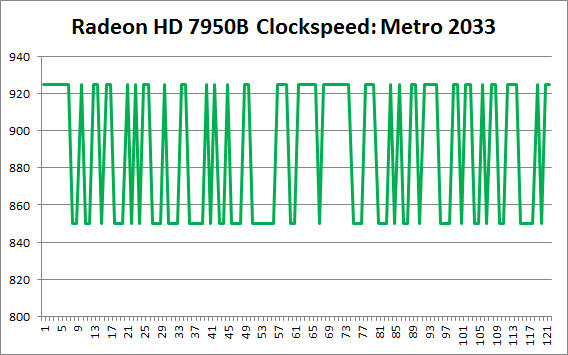
The above is a graph of clockspeeds when running Metro 2033 at 1920x1200, and it’s virtually identical to what we see with other games. The 7950B fluctuates wildly between its base state and its boost state. This is not the kind of behavior we see from the 7970GE or for that matter NVIDIA’s GTX 600 cards. This fluctuating behavior is unique to the 7950B.
So what’s going on? As near as we can tell, the power requirements for boosting are so high that the 7950B simply cannot maintain that boost for any significant period of time. Almost as soon as the 7950B boosts needs to go back to its base state in order to keep power consumption in check. The culprit here appears to be the 7950B’s very high boost voltage of 1.25v, which at 0.125v over the card’s base voltage makes the boost state very expensive from a power standpoint. If our theory is correct then this means that the 7950B never gets very far past its base clockspeed, and compared to the 7970GE, PT Boost is almost entirely wasted here.
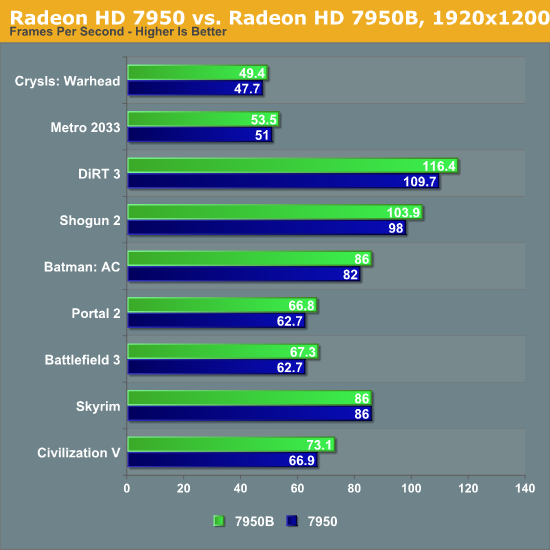
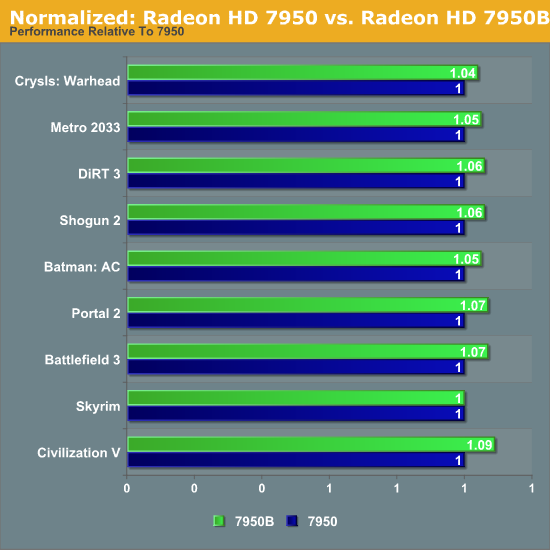
Looking at our performance charts, what we’re seeing would seem to confirm our theory. Keeping in mind that the base clockspeed of the 7950B is 6.25% higher than the 7950, the only time we see a significant jump in performance beyond that is with Civilization 5, where performance increases by 9%. Otherwise performance increases by merely 4% in Crysis, up to 7% in Battlefield 3. Not counting Skyrim (which is CPU limited), we’re looking at an average performance gain of just over 6%, which is very close to the increase in the base clockspeed relative to the 7950.
As we’ve stated before this is free performance and we’re happy to take it, but at the end of the day 6% is not nearly enough to matter with the current competition. Until such a time where the competitive landscape changes, the 7950 will continue to be well behind its next-closest competitor, GTX 670.
Power, Temperature, & Noise
Bringing things to a close, we quickly wanted to break out power, temperature, and noise. As we’ve stated earlier, AMD is making a clear set of tradeoffs with the 7970GE and 7950B, forgoing power efficiency in the name of performance. We’ve seen the 6% performance boost the 7950B offers, but what exactly has the cost been?
| Radeon HD 7950 Series Voltages | ||||
| Ref 7970B Base Voltage | Ref 7950B Boost Voltage | Ref 7950 Base Voltage | ||
| 1.125v | 1.25v | 1.093v | ||
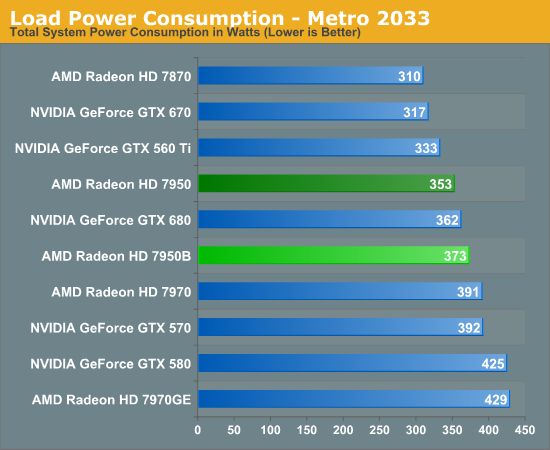
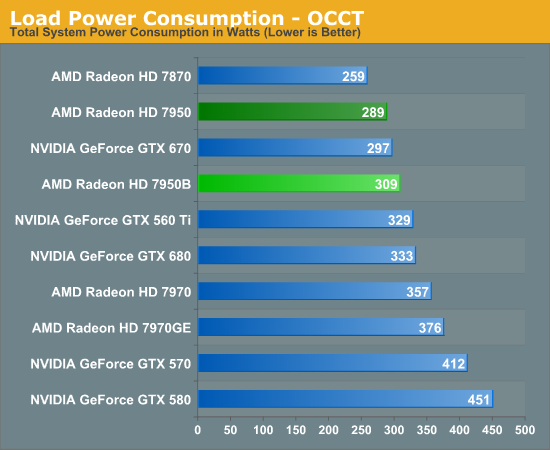
Starting as always with load power, we see that relative to the 7950, the 7950B’s power consumption at the wall is 20W higher in both tests. This fits well with AMD’s official specs, which have the TDP of the 7950B at 225W, versus 200W for the 7950. As a result of this power increase the 7950B draws more power than even the GTX 680 when it comes to Metro, though thanks to AMD’s more rigorous throttling their power consumption still comes in below the GTX 680 under OCCT.
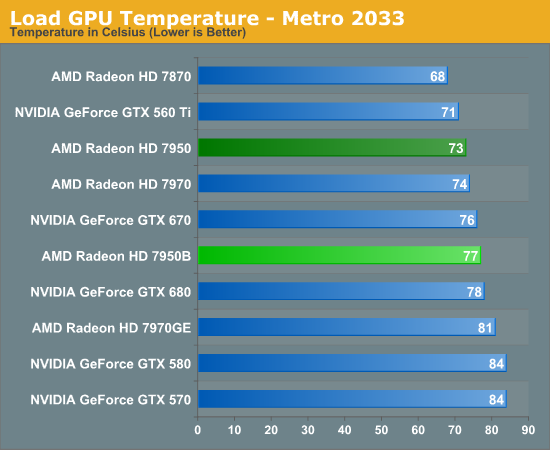
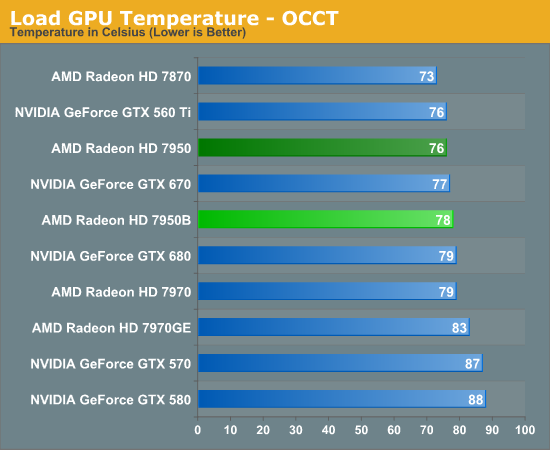
Moving on to load temperatures, it comes as no great surprise that with an increase in power consumption comes an increase in load temperatures. The 7950B still fares well here, staying below 80C in both tests, but the 4C jump in Metro is a bit more than we would have expected for only a 20W increase in power consumption.
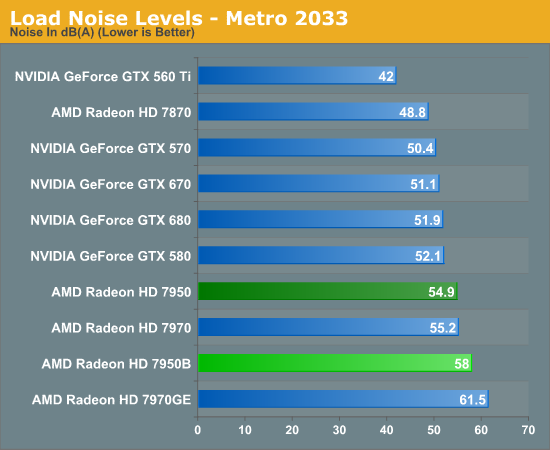

Last but not least we have our look at noise under load. Unfortunately the 7950B looks especially bad here, thanks to the more aggressive fan curve we typically see on 7950 cards. With both Metro and OCCT the 7950B is pushing 58dbA+, which is louder than even the better performing 7970. In fact all things considered this is quite a ridiculous amount of noise, the same problem the 7970GE had.
The good news is that the reference 7950 is rarely sold these days, but we have every reason to believe that aftermarket cards will see a similar jump in noise. There’s no getting around the fact that 225W is a lot of heat to dissipate, especially for designs that weren’t necessarily optimized around that level.
Wrapping things up, it’s difficult to hold a favorable opinion of the 7950B given what we’ve seen so far. AMD may be putting all of their focus into performance-per-dollar, but that doesn’t mean that performance-per-watt has suddenly stopped mattering. The 7950B’s performance boost is free from a price perspective, but the tradeoff that comes with it is anything but. A 6% jump performance for a 10% increase in power consumption and notable rise in load noise will certainly be acceptable to some users, but it’s difficult to argue that this is a good tradeoff overall.










58 Comments
View All Comments
Ryun - Tuesday, August 14, 2012 - link
I would rather AMD just lower the price of the 7950 as a consumer, but coming from their perspective it probably makes more sense to increase performance but keep the price the same.RussianSensation - Tuesday, August 14, 2012 - link
Previous MSRP was $449.99, then $349.99 and now it's falling to $329.99.The thing is you don't have to get a reference 7950B with an overvolted BIOS. There are plenty of after market 7950 cards that can hit 1.1-1.15ghz with 1.15V for example. MSI TwinFrozr III and Gigabyte Windforce 3x 7950 cards come to mind and both can be purchased on Newegg, Amazon, Superbiiz for $320-330 or sometimes even $310. This way the consumer gets the best of all worlds:
1) Upgraded cooling to reduce noise and better handle overclocking above 925mhz;
2) Better binned Tahiti chips (esp. in the case of the TF3) that can overclock well on much lower voltage;
3) The power consumption increase is a lot less dramatic with cream of the crop 7950 cards that can hit 1.1ghz+ with voltages way under 1.2V. It would make sense that the reference 7950B cards would get the worst possible Tahiti chips since reference design isn't really made for much overclocking headroom.
It will be interesting to see how GTX660Ti compares since at 925mhz, HD7950 is roughly 5-6% behind the 7970 which is just 3-4% behind the 670.
just4U - Tuesday, August 14, 2012 - link
Ryan sort of leads readers to believe 7950 is well behind the 670. I'd always thought it was within a 5-10% margin and with these new incarnations would lessen the gap even more. Not that it matters. It's still (imo) 680 670/7970 then the 7950... and current prices reflect that.RussianSensation - Wednesday, August 15, 2012 - link
Ya, that's because if you saw how the GPU Boost reacts, it doesn't stay pegged at 925mhz as would be the case with a manually overclocked 925mhz 7950. This is why the average increase in speed is only 5-6% on the 7950B as opposed to 10-12% you'd see on the regular 7950 manually overclocked to 925mhz.CeriseCogburn - Saturday, August 25, 2012 - link
This card is a stupid amd brain fart, right ? I mean all you freaks claim all the amd fans OVERCLOCK or they wouldn't be buying these high end cards....So were you lying or is amd stupid as dirt ?
raghu78 - Wednesday, August 15, 2012 - link
well said. Factory overclocked cards like Sapphire HD 7950 950 Mhz edition have very good cooler design, enthusiast friendly features like Dual BIOS for aggressive overclocking and excellent binning. These cards overclock to 1150 Mhz or higher speeds with a bit of voltage tweaking. And here we are talking about completely moot points. clock for clock HD 7950 is 3 - 5% slower than HD 7970. As for performance GTX 670 and HD 7950 are competitive when overclocked. the Sapphire HD 7950 950 Mhz edition can be had for USD 350 at newegg. so generally HD 7950 has better price perf and similar overclocked performance.skgiven - Sunday, August 19, 2012 - link
Good points.I don't see any place for this card in the existing market. It's basically competing with itself, or bespoke/non-reference manufacture versions of the card, and I don't think it compares well against those. Why annoy your partners by trying to elbow in an unwanted reference design?
The extra speed really does come at a price, not cash but a 1.125 base Voltage. This is very high (we are talking about the same territory as the first HOT Firmi's), and an extra 25W is a lot. We have come to expect improved efficiency with refreshes, not a 12.5% increased power requirement for a mere 6% performance improvement. Just a bad card that looks even worse against the 660Ti's load power requirements. I would consider a manufacturer's bespoke implementation of a HD7950 but not this B grade effort.
"It will be interesting to see how GTX660Ti compares since at 925mhz, HD7950 is roughly 5-6% behind the 7970 which is just 3-4% behind the 670".
But which GTX660Ti? Although there is a sort of basic spec/reference model there is a huge range of GTX660Ti cards from 925MHz to 1033MHz (so far). That's a performance range of over 11% (or 13% if you go by boost clocks). Some even have higher clocked GDDR5 and some have 3GB instead of 2GB. So there is plenty of diversity/competition. Some performances of the 'superclocked' cards even pass a reference GTX670 (Portal 2).
AMD need a proper refresh, to regain the lead, not a supped up reference card...
Jamahl - Tuesday, August 14, 2012 - link
I agree that the power difference makes this somewhat a double-edged sword.I disagree with one part of your conclusion however - having compared both in your bench - http://www.anandtech.com/bench/Product/598?vs=645 the 7950 is starting to look a bit closer to the gtx 670, don't you agree?
it's only 12% behind at 1920x1200, and really that outlying battlefield result (34% faster on the 670) seems to be making a lot of the difference. Remove that one and it's 9% - then what will happen if you switch out Dirt 3 for Dirt Showdown? Not much in it all of a sudden.
RussianSensation - Wednesday, August 15, 2012 - link
Exactly. Also a lot of 7950s scale well past 1.1ghz and there are certain games not in the test bench that run well on AMD cards: Sniper Elite V2, Anno 2070, Bulletstorm, Serious Sam 3, SKYRIM with mods, Risen Dark Waters.bill4 - Tuesday, August 14, 2012 - link
"Until such a time where the competitive landscape changes, the 7950 will continue to be well behind its next-closest competitor, GTX 670"Umm, yeah, and it's also well behind it in price too. Like, $80-$100. Comparing them is stupid, so why did you do it? Compare it to a 560 Ti or something if you just have to compare it to something from Nvidia. This thing will fight the 660 Ti, and guess what, it'll compete well!
Reviewers really seem to have it out for AMD lately. I dont think Ryan does, I think it was just a clumsy review.
This seems a little pointless, but by the same token so is Nvidia's boost and reviewers love that. The bottom line is 6% more on some bar graphs makes the 7950 look better to some buyers, and thats why they did it. Nvidia's cards are auto overclocking, so they were gaining an unfair advantage in "stock" reviews. No more.
Nvidia started all this with their boost, I applaud AMD competing.
BTW, zero mainstream reviewers have yet addressed the obvious and fundamental issue that Nvidia is (surely) cherry picking their review samples, which with boost means it is actually performing better than the cards the public will buy (the Way AMD's boost works it isn't the case for them). This amazes me, as it was literally the first thing that came to my mind when reading first reviews of Nvidia's new cards. Nvidia has the media in it's pocket.